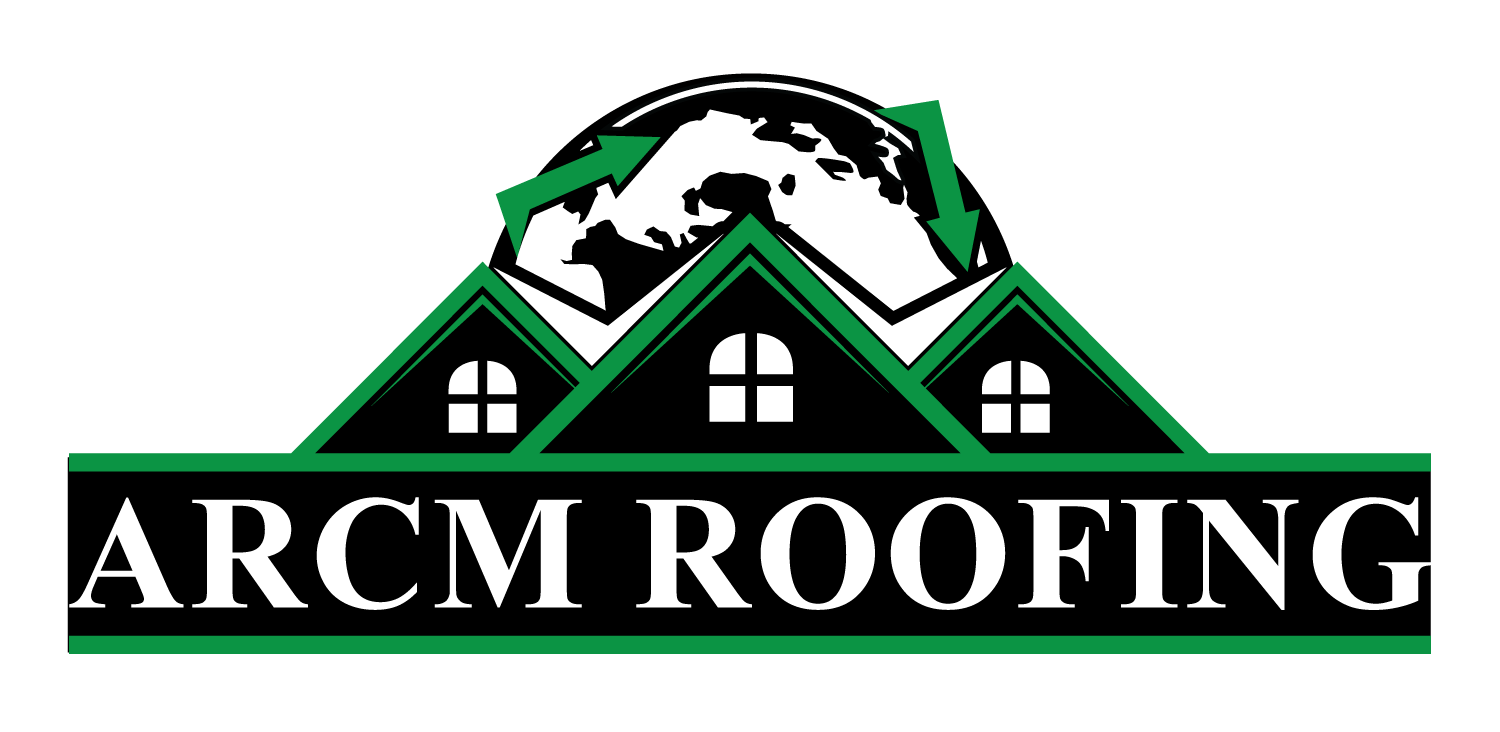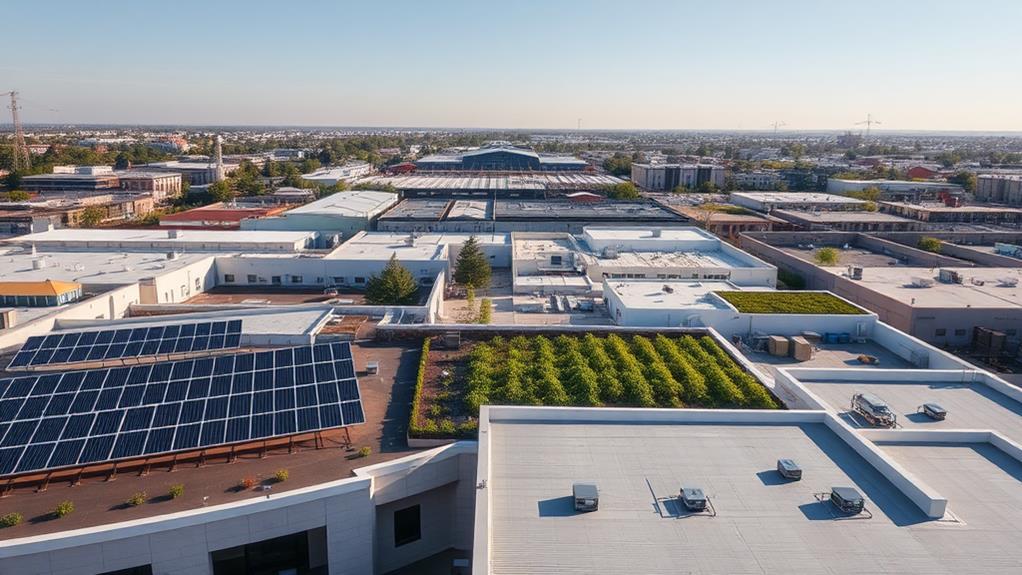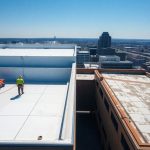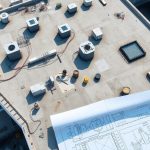Commercial roofing solutions for businesses and larger buildings are pivotal in guaranteeing longevity, energy efficiency, and cost-effective upkeep. These solutions often involve specialized materials such as single-ply membranes, modified bitumen, and metal roofing, each chosen for its durability and ability to handle weather and physical impacts. The installation process demands skilled professionals to ensure proper integration with the building’s systems, maintaining compliance with safety standards. Employing advanced insulation and reflective coatings further enhances energy efficiency, potentially reducing costs dramatically. Regular maintenance and timely inspections extend roof lifespan, protecting investments. Discover how these solutions foster sustainability and economic resilience.
Roofing Highlights
- Commercial roofing optimizes energy efficiency with materials like single-ply membranes, reducing cooling costs by up to 30%.
- Durable materials such as metal and modified bitumen offer weather resistance and extend roof lifespans to 20-30+ years.
- Regular inspections and maintenance programs identify issues early, preventing costly damage and ensuring long-term sustainability.
- Sustainable roofing options, like green roofs, contribute to reduced energy usage and heat island mitigation.
- Proper insulation with materials like rigid foam minimizes energy costs, enhancing thermal efficiency by up to 40%.
Definition of Commercial Roofing
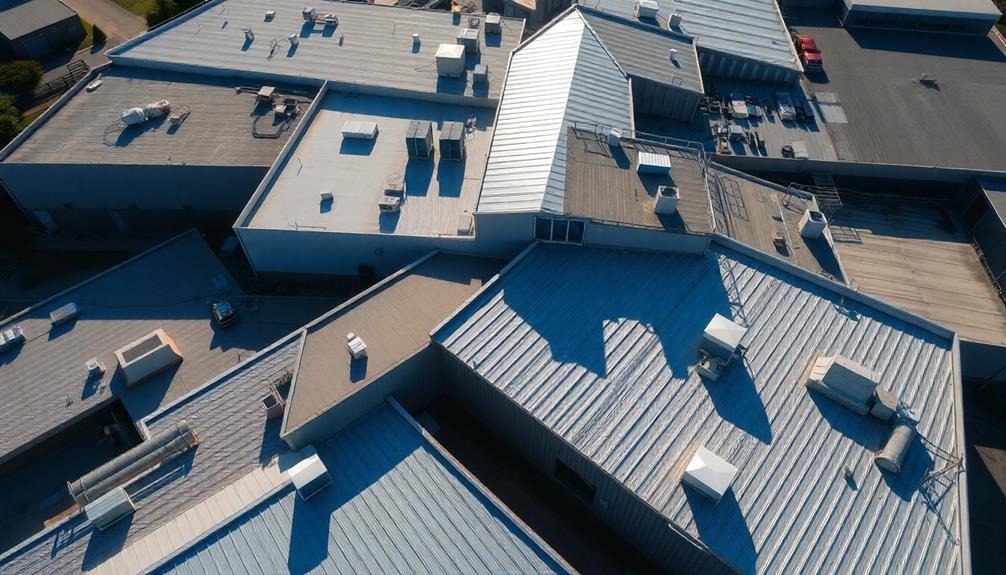
Commercial roofing is an essential component in maintaining the structural integrity and energy efficiency of larger buildings, demanding a thorough understanding of its purpose and importance to guarantee long-lasting protection against environmental elements.
The variety of materials available, such as single-ply membranes, modified bitumen, and built-up roofing systems, offer diverse benefits tailored to the specific needs and environmental considerations of each commercial property.
A well-executed installation process, complemented by regular maintenance and inspections, is critical in optimizing the performance and lifespan of these intricate roofing systems.
Purpose and Importance
A building’s roof plays an essential role in maintaining its structural integrity and enhancing its overall functionality, especially in the domain of commercial properties. Commercial roofing systems are crucial for protecting diverse commercial buildings—from retail centers to data warehouses—by utilizing specialized roofing materials designed to withstand unique challenges such as heavy equipment loads and foot traffic.
The importance of these systems lies in their ability to optimize energy efficiency and facilitate significant cost savings. By selecting appropriate commercial roofing solutions, businesses can enjoy not only reduced maintenance costs but also an extended roof lifespan, thanks to materials like single-ply membranes or metal roofing.
Engaging roofing contractors for regular roof inspections and maintenance confirms these systems remain robust, meeting industry standards and minimizing disruptions caused by damage. A focus on sustainable design further enhances a system’s contribution to environmental sustainability and long-term financial benefits for owners.
Comprehensive roof maintenance and timely repairs are pivotal, safeguarding a commercial property’s investment while complying with building codes. As enterprises aim towards communal and ecological belonging, adopting energy-efficient technologies and green roofing can prove instrumental, offering substantial dividends through meticulous care and strategic planning of their commercial roofing systems.
Material Options Explained
Understanding the variety of material options available for commercial roofing systems is essential for selecting the most suitable solution to meet specific building needs and challenges. Commercial properties demand roofing systems that balance energy efficiency, durability, and longevity.
Among the prevalent choices is the single-ply membrane, including TPO, PVC, and EPDM, which offers lightweight and reflective qualities. Known for its resistance to chemicals and UV damage, single-ply membrane roofing is particularly popular for low-slope commercial roofs due to its efficacy in providing enduring protection.
Meanwhile, modified bitumen emerges as a robust option, melding traditional asphalt benefits with polymer-modified flexibility. This hybrid stands out for its enhanced strength and waterproof nature, effectively safeguarding commercial buildings against various environmental elements.
Built-up roofing further complements these solutions with layers of roofing felt and asphalt, delivering exceptional resilience against weather conditions, making it well-suited for flat or low-slope commercial structures.
Lastly, metal roofing presents a durable, fire-resistant, and sustainable choice, appreciated for both its long-term performance and contribution to energy efficiency. As this option comes in several materials, it offers versatility and reliable longevity, suitable for diverse commercial settings. This array of materials equips businesses with reliable options tailored to individual architectural and environmental demands.
Installation Process Overview
Selecting the right material for a commercial roof is only the beginning; the installation process plays a pivotal role in the overall performance and longevity of the system. A commercial roofing project involves meticulously installing specialized materials like single-ply membranes, metal, or modified bitumen, each chosen to protect and insulate larger structures while enduring heavier loads and demanding weather conditions that are typical for commercial environments.
The complexity of such roofing systems necessitates the deployment of specialized equipment and techniques. Roofing professionals with expertise in commercial roofing services employ precision to guarantee proper placement, sealing, and integration with existing building systems.
Throughout the installation process, adherence to code compliance and safety procedures is crucial, minimizing any potential disruptions to ongoing business operations. Each type of commercial roofing demands a tailored approach, whether leveraging the lightweight benefits of single-ply systems or the durability of metal options.
Regular inspections and proper maintenance work in tandem with professional installation, extending the roof’s lifespan and ensuring its continuous energy efficiency. Proactively partnering with skilled roofing professionals not only optimizes the installation process but helps foster a sense of belonging and assurance within the business community.
Benefits

Commercial roofing solutions offer significant benefits that span energy efficiency, longevity, environmental impact reduction, and cost-effective maintenance. By utilizing advanced materials and technologies like TPO, PVC, cool roofs, and green roofs, these solutions enhance a building’s energy performance, potentially lowering utility costs by up to 30%, while simultaneously mitigating adverse environmental effects such as the urban heat island phenomenon.
Additionally, robust maintenance programs are essential for extending the roof’s lifespan by up to 20 years, ensuring the protection of the property investment and allowing for the early identification and resolution of potential issues, consequently avoiding the high costs associated with roof replacements.
Energy Efficiency Advantages
Energy-efficient commercial roofing solutions offer substantial benefits, primarily through enhanced reflectivity, superior thermal insulation, and potential energy self-generation. By improving energy efficiency, these innovative systems can drastically reduce a building’s cooling costs by up to 30%. Through increased reflectivity, roof coatings work diligently to lower peak cooling demand by 10-15%, allowing for precise HVAC system sizing and utility cost savings.
Additionally, green roofs with vegetation not only combat urban heat island effects but also decrease energy usage by 0.7% to 6% compared to traditional roofs, creating a more sustainable urban environment.
Proper roof insulation plays a pivotal role, improving a building’s energy efficiency by 30-50%, consequently decreasing heating and cooling expenses. This level of thermal insulation fosters a comfortable and cost-effective habitat for occupants, aligning with community values of environmental stewardship.
The integration of photovoltaic solar panels represents the apex of energy efficiency, capable of offsetting up to 100% of a building’s electricity consumption by generating clean, renewable energy on-site. This holistic approach to roofing solutions affirms a commitment to energy efficiency, supporting businesses and larger buildings in reducing their carbon footprint while maintaining an inclusive, forward-thinking community.
Longevity and Durability
The longevity and durability of commercial roofing systems stand as fundamental benefits that bolster their appeal for businesses. Designed using high-quality materials, these roof systems are capable of lasting 20-30 years or more, offering longevity that reassures building owners. Structures crafted from durable roofing materials like metal and modified bitumen are especially favored for their remarkable resistance to harsh weather conditions and physical damage. Such resilience is indispensable for maintaining structural integrity during extreme weather events such as heavy winds, hail, and snowstorms. For building owners seeking reliability, the choice of roofing materials becomes paramount.
Proper maintenance is essential in extending the lifespan of these commercial roofing systems, ensuring their durability and efficiency. Regular inspections paired with preventative maintenance play an indispensable role in mitigating the need for frequent and costly roof replacements, translating into significant long-term savings. The economic benefits of sustained durability are further enhanced by long-term warranties on commercial roofing products, providing building owners with additional peace of mind and financial protection. These warranties affirm the quality commitment behind the roof systems, fostering a sense of security and belonging within the business community, impatient to cultivate enduring investments.
Environmental Impact Reduction
Innovative roofing strategies for commercial buildings play a crucial role in reducing environmental impact while offering substantial long-term benefits. Green Roofing initiatives, such as those implemented under Denver’s Green Roof Ordinance, are pioneering examples. By potentially creating 3.5 million square feet of green space by 2050, these initiatives extensively mitigate urban heat island effects and reduce greenhouse gas emissions, positively impacting the community and the environment.
Roof Coatings, particularly liquid-applied types, are indispensable in maintaining moderate building temperatures, enhancing energy efficiency, and providing a cost-effective alternative to full roof replacement. These solutions reflect solar energy, minimizing energy consumption and reducing cooling costs.
Similarly, Single-ply Roofing membranes like TPO and PVC are renowned for their reflectivity, playing a key role in lessening heat absorption and further decreasing cooling expenses.
Metal Roofing stands out for its durability and longevity, contributing to a lower environmental footprint by reducing the frequency of roof replacements. When combined with advanced Thermal Insulation and cover boards, these roofing solutions substantially enhance energy efficiency, leading to reduced carbon footprints and lower utility bills. Collectively, these measures position commercial roofing as a cornerstone of sustainable architectural practices.
Cost-Effective Maintenance
Utilizing diligent maintenance strategies for commercial roofing considerably enhances the property’s value and longevity. Regular maintenance, including Roof Inspection and preventative maintenance, plays a pivotal role in identifying potential issues early, thereby averting costly damage or full roof replacement. By incorporating roof coatings and timely roof repairs, businesses not only save up to 70-80% in costs compared to a full roof replacement but also extend the roof’s lifespan by 10-15 years, reinforcing the property’s investment.
Moreover, engaging in routine inspections establishes a proactive approach to roof care. These inspections are indispensable for uncovering minor defects that might otherwise lead to significant disruptions in daily operations. The adherence to such disciplined maintenance protocols is further rewarded through tax-deductible advantages, supporting businesses in managing costs efficiently.
Warranty programs also benefit from regular maintenance, as they require consistent upkeep to offer coverage lasting up to 35 years. Upholding these programs guarantees long-term security and reassures facility managers of sustainable roofing solutions. This cost-effective pathway not only fosters a sense of belonging within the business community by securing assets but also aligns operational efficiency with fiscal responsibility, fulfilling both environmental and economic objectives.
Insulation Effectiveness Insights
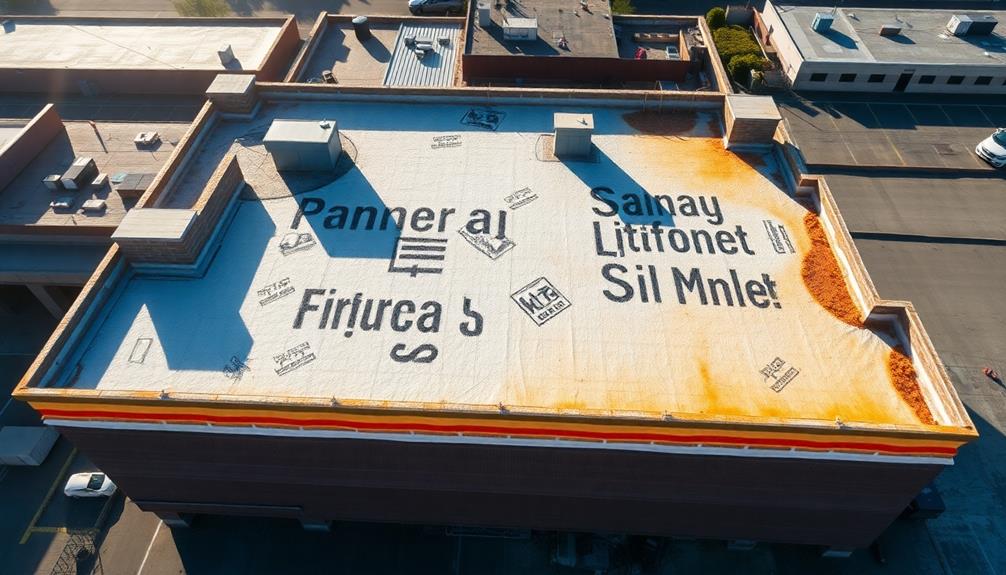
In the pursuit of essential energy efficiency in commercial buildings, understanding various types of insulation plays a pivotal role, as evidenced by their capacity to dramatically reduce energy costs and consumption. Insights into insulation effectiveness not only underscore the importance of selecting high-performance materials but also highlight the symbiotic relationship between insulation and other solutions like reflective coatings and cool roofing, which collectively enhance a building’s energy performance. The table below summarizes the key benefits associated with insulation and additional roofing solutions that contribute to cost-effective energy management strategies:
| Solution Type | Energy Efficiency Benefit |
|---|---|
| Rigid Roof Insulation | Reduces energy costs by up to 10% |
| Proper Ventilation | Decreases heat transfer by up to 50% |
| Reflective Coatings | Lowers cooling load by 10-15% |
| Radiant Barriers | Reduces HVAC energy use by 5-10% |
| Cool Roofing Combo | Cuts annual consumption by up to 30% |
Types of Insulation
Understanding the different types of insulation is essential for optimizing thermal performance in commercial roofing systems. Selecting the right insulation can lead to remarkable improvements in energy conservation and occupant comfort. Rigid foam insulation is among the most popular choices owing to its high R-values and effectiveness at minimizing heat transfer. Polyisocyanurate and extruded polystyrene are prominent examples, offering robust thermal resistance and reducing energy loss in roofs and walls.
Meanwhile, fiberglass batt insulation presents a cost-effective solution for various building cavities, with R-values ranging from R-13 to R-23, suiting diverse structural needs.
Spray foam insulation, available in both open-cell and closed-cell forms, distinguishes itself through its superior air sealing capacity. It dramatically reduces air leaks, achieving exceptional R-values of up to R-7 per inch. This versatility makes it ideal for intricate areas where air barriers are indispensable.
Additionally, cellulose insulation, derived from recycled materials, enhances thermal performance through high thermal mass. This characteristic aids in stabilizing indoor temperatures by mitigating rapid fluctuations.
For any insulation type chosen, proper installation is indispensable. Imperfect installation, leading to issues like thermal bridging, can considerably diminish the insulation’s effectiveness, underscoring the importance of professional expertise in this domain.
Energy Efficiency Benefits
Frequently overlooked yet immensely impactful, effective roof insulation plays a pivotal role in enhancing a building’s energy efficiency. By reducing energy consumption by up to 40%, proper insulation substantially decreases costs associated with heating and cooling systems, such as HVAC units. High-performance insulation materials like polyisocyanurate, featuring R-values up to R-6.5 per inch, maximize thermal resistance. This fosters an environment where heating and cooling efficiency is maximized, directly safeguarding against unnecessary energy expenditure.
Adding just one inch of rigid roof insulation amplifies energy efficiency by 10-15%, demonstrating how seemingly small adjustments have significant impacts. Complementing this with cool roofing materials that reflect sunlight further reduces cooling loads by another 10-15%. These reflective surfaces enhance overall energy performance, fundamentally maximizing resource use for better efficiency outcomes.
As studies indicate, the synergy of reflective roof coatings and excellent insulation can diminish HVAC energy use by up to 50%. This blend not only benefits the environment by reducing carbon footprints but also bolsters your business’s financial health through energy savings. Investing in enhanced roof insulation offers businesses a pragmatic approach to achieving greater energy efficiency and collective sustainability goals, fostering a sense of communal responsibility.
Cost-Effective Solutions
Employing cost-effective insulation solutions is integral to enhancing both energy efficiency and financial viability for commercial properties. In managing a commercial property, strategic insulation can remarkably reduce energy costs by up to 30%, offering substantial financial relief.
Adopting high-performance insulation materials such as spray foam or rigid foam boards in new commercial roofing projects greatly increases the R-value, often by more than 50%. This improvement is vital for both Flat Roofing and various types of roofing systems aimed at residential and commercial use. Enhanced insulation in Flat Roofs, combined with reflective roof coatings, helps reduce cooling loads by up to 15%, effectively diminishing HVAC expenses while promoting sustainability.
The selection of appropriate roofing systems and strategic insulation placement in critical areas, such as roof penetrations and thermal bridges, can further elevate the thermal efficiency of the building envelope. This approach not only helps reduce overall energy costs but also extends the life of the roofing and infrastructure. Additionally, commercial properties investing in advanced insulation and cool roofing technologies may become eligible for tax credits and government incentives, providing additional financial benefits. Consequently, integrating these solutions fosters a shared ethos of economic and environmental resilience within business communities.
Roofing FAQ
What Types of Materials Are Commonly Used for Commercial Roofing?
Commercial roofing typically employs materials such as TPO, PVC, modified bitumen, EPDM rubber, and liquid-applied coatings. Each offers unique advantages, including durability, flexibility, and energy efficiency, making them suitable for diverse building requirements and environmental conditions.
How Often Should Commercial Roofs Be Inspected for Maintenance?
Commercial roofs should undergo inspections at least annually, ideally in spring and fall. Regular inspections preserve roof integrity, comply with warranty requirements, and prevent costly repairs. Immediate inspections post-major weather events mitigate potential damage and guarantee long-term durability.
Are There Eco-Friendly Roofing Options Available for Businesses?
Eco-friendly roofing options for businesses include green roofs for reducing heat and managing stormwater, solar panels for renewable energy, cool roof coatings for energy efficiency, and recycled materials for sustainability. These choices support environmental responsibility and operational effectiveness.
What Is the Average Lifespan of a Commercial Roof?
The average lifespan of a commercial roof varies based on material and maintenance. Asphalt roofs last 10-20 years, single-ply membranes 20-30 years, and metal roofs up to 50 years, with proper care extending durability considerably.
How Should Businesses Choose a Commercial Roofing Contractor?
Choosing a commercial roofing contractor involves gauging their experience, reputation, and credentials. Verify licenses and insurance, seek recommendations, and evaluate past projects. Guarantee clear communication and inclusive warranties to foster trust and successful long-term partnerships within the business community.
